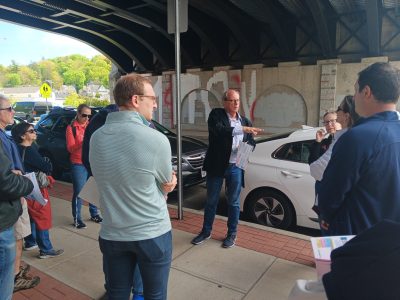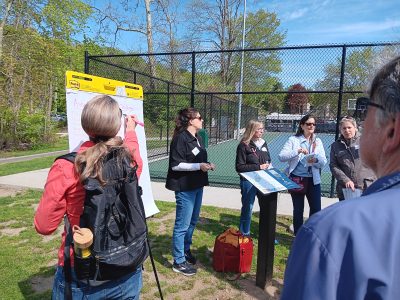Walking Tour Kicks Off Effort to Explore Downtown Chappaqua Uses
News Based on facts, either observed and verified directly by the reporter, or reported and verified from knowledgeable sources.

The process of exploring future uses for town-owned land in downtown Chappaqua commenced on Saturday as residents participated in an interactive walking tour to provide feedback to the New Castle Town Board and its consultants.
More than 60 residents visited five separate locations within the 23-acre area around the Chappaqua train station, offering their opinions to town personnel and consultants regarding the assets and challenges and what their desires are for each spot. The locations were the south parking lot at Town Hall near the playground and basketball courts; train station parking lots C and D; the north end of the train station lot near the Route 120 bridge; the parking area behind Pizza Station; and on South Greeley Avenue near the entrance to Town Hall.
Town Director of Planning Sabrina Charney Hull said the feedback from the walking tour will be discussed at two engagement sessions starting Monday evening and resuming on May 15 at Robert E. Bell Middle School and will be included in a report to the Town Board from Nexus Creative Design and the Pace Land Use Law Center, the town’s consultants.
“This is an opportunity for the community to tell the Town Board what they like, what they don’t like and things that you may want in the future,” Hull said.
Information from the walking tour and what has been collected online at the www.envisionnewcastle.org website will be discussed at the two workshops, she said.
Before the walking tour began, architect Jaclyn Tyler, part of the team at Nexus Creative Design, instructed several groups of about 15 to 20 people each to observe the surroundings and imagine the possibilities through a process called “placemaking.” Tyler stressed that placemaking “does not mean development.”
John Fry, also part of the Nexus team, described placemaking as part art and part science.
“We’re not so much here today to implement a deep dive into the particulars of placemaking, it’s about gathering your observations as placemakers,” Fry said. “The 23 acres here is an interesting collection of placemaking over time, some of it by design, some of it not so much by design.”
He said spots such as the Chappaqua train station that were designed for a specific purpose have evolved over time.

During one group’s stop at parking lots C and D near the train station, it was raised how a portion of the parking lots are used for recreation, as children with their parents were bike riding off in a remote portion of the lots. Some possibilities included how there could be more landscaping and greenery or even a place for a town pool.
At another stop, residents remarked about the difficulty of the traffic patterns at or near the train station, but also the convenience of free parking downtown.
Duff Bailey, a 37-year Chappaqua resident who participated in the walking tour, said it was important for there to be a free-flowing exchange of ideas between the public and the planners to get a gauge of what people would like to see, a critical first step.
“I think it’s important for the planners to get the desires, the sense of what’s critical and then figure out what’s feasible,” Bailey said.
While discussion of what to do with at least some of the town-owned land has been raised periodically for years, it has surfaced repeatedly since the start of the pandemic when the train station parking lot has been underused. A key unanswered question is what amount of commuter parking will be needed in the future.
Supervisor Victoria Tipp, who attended Saturday’s walking tour, said even though Town Board members each have their own ideas about the possibilities for town-owned land, such as the need to address shortcomings at New Castle Town Hall, the sessions were an opportunity for residents to weigh in. Several residents have already expressed concerns on local social media that this effort is not an attempt to revive the ill-fated Form Based Code.
Tipp said as new families move into town and evolving changes continue since the pandemic, it will be intriguing to see what the public suggests.
“We do have our constraints as well. A lot of the downtown land is part of the school district, which is not within our purview to change,” Tipp said, also pointing out how Bell Middle School and the library, which take up significant space, limit what can be done by the town. “All of these are advantages and assets, which also takes up a lot of our downtown space.”
Hull said that depending on how the Town Board chooses to proceed, she expected a survey to go out later this year incorporating much of what is compiled from the walk and the engagement workshops.
“The intention is that the Town Board will utilize that when compiling a town-wide survey about the town-owned land that will probably be developed in the fall,” Hull said. “It’s really up to the Town Board those next steps but the idea is that this information would be put into a survey that will be distributed to every property owner in this vicinity.”
The sessions on Monday and on May 15 are both at the Bell Middle School at 7 p.m. For more information about the New Castle’s Community Visioning Outreach Program, visit www.envisionnewcastle.org.

Martin has more than 30 years experience covering local news in Westchester and Putnam counties, including a frequent focus on zoning and planning issues. He has been editor-in-chief of The Examiner since its inception in 2007. Read more from Martin’s editor-author bio here. Read Martin’s archived work here: https://www.theexaminernews.com/author/martin-wilbur2007/
